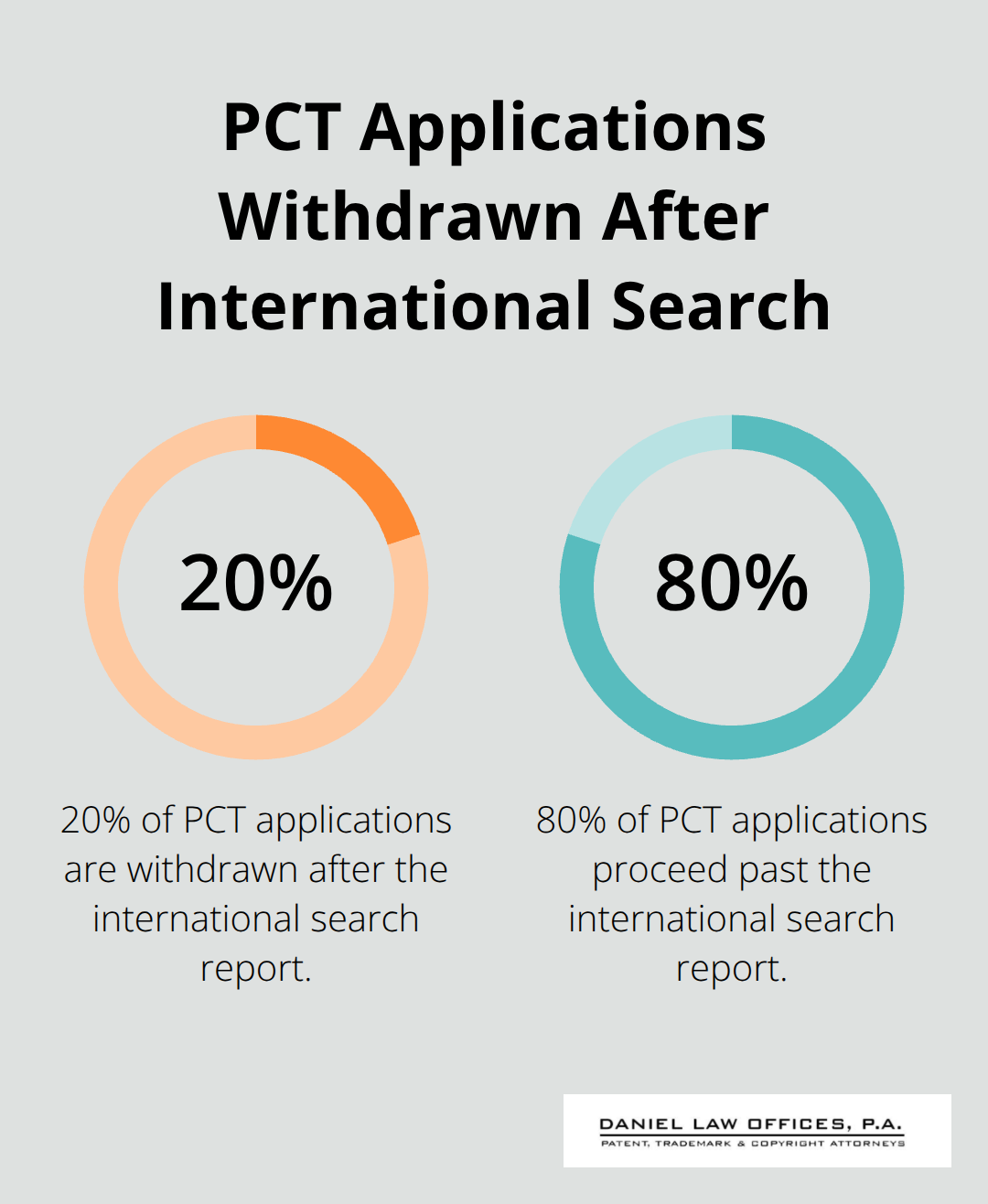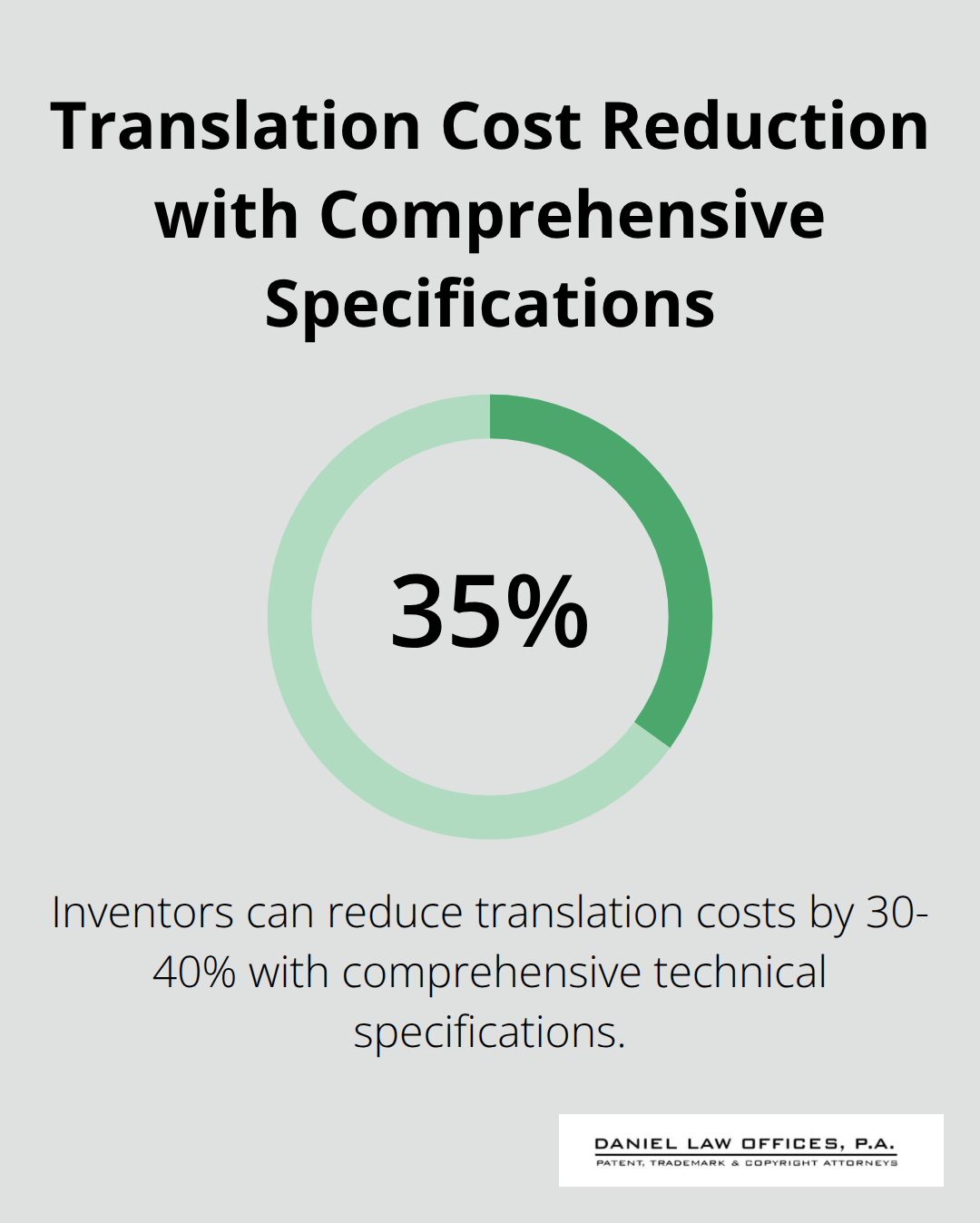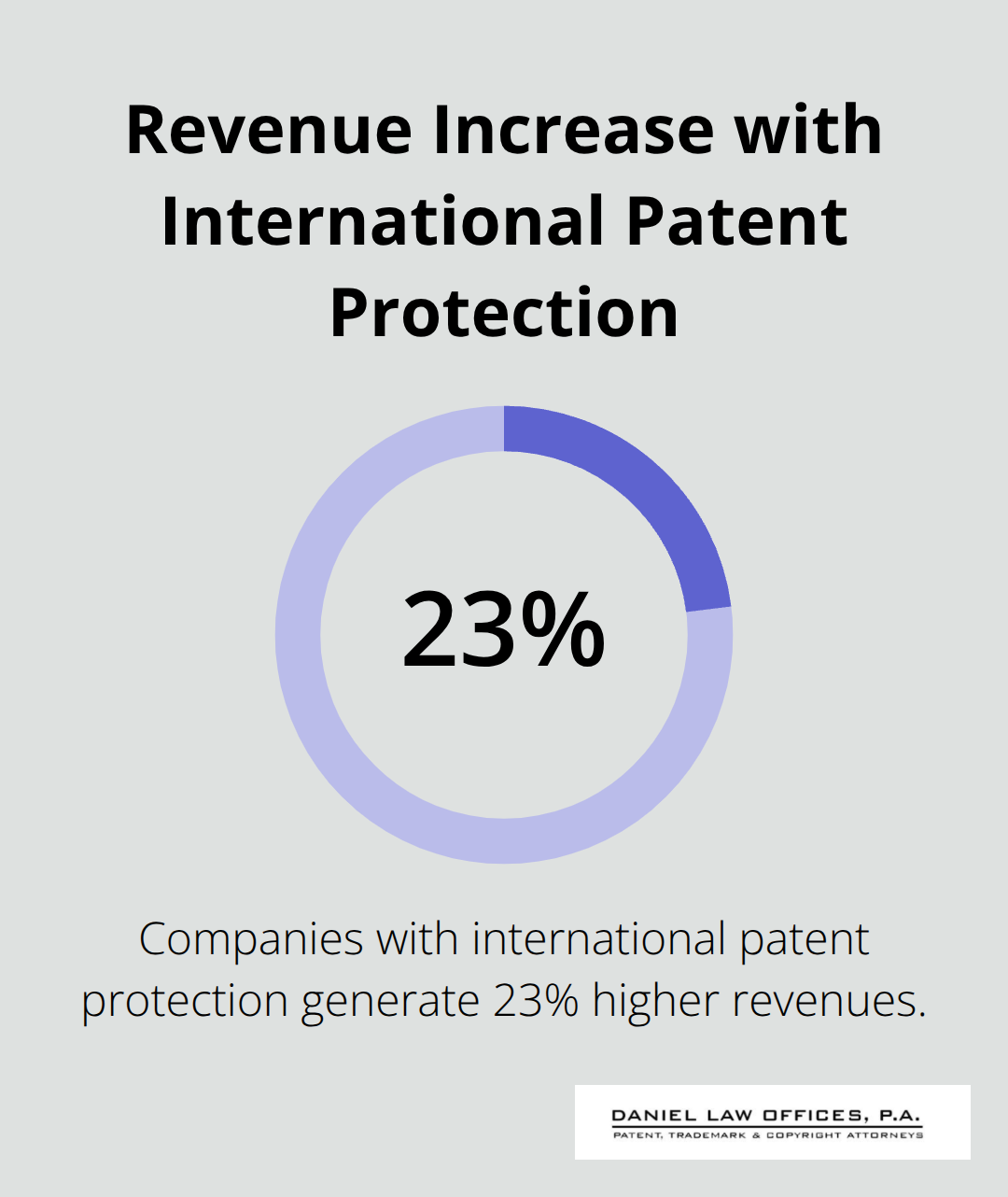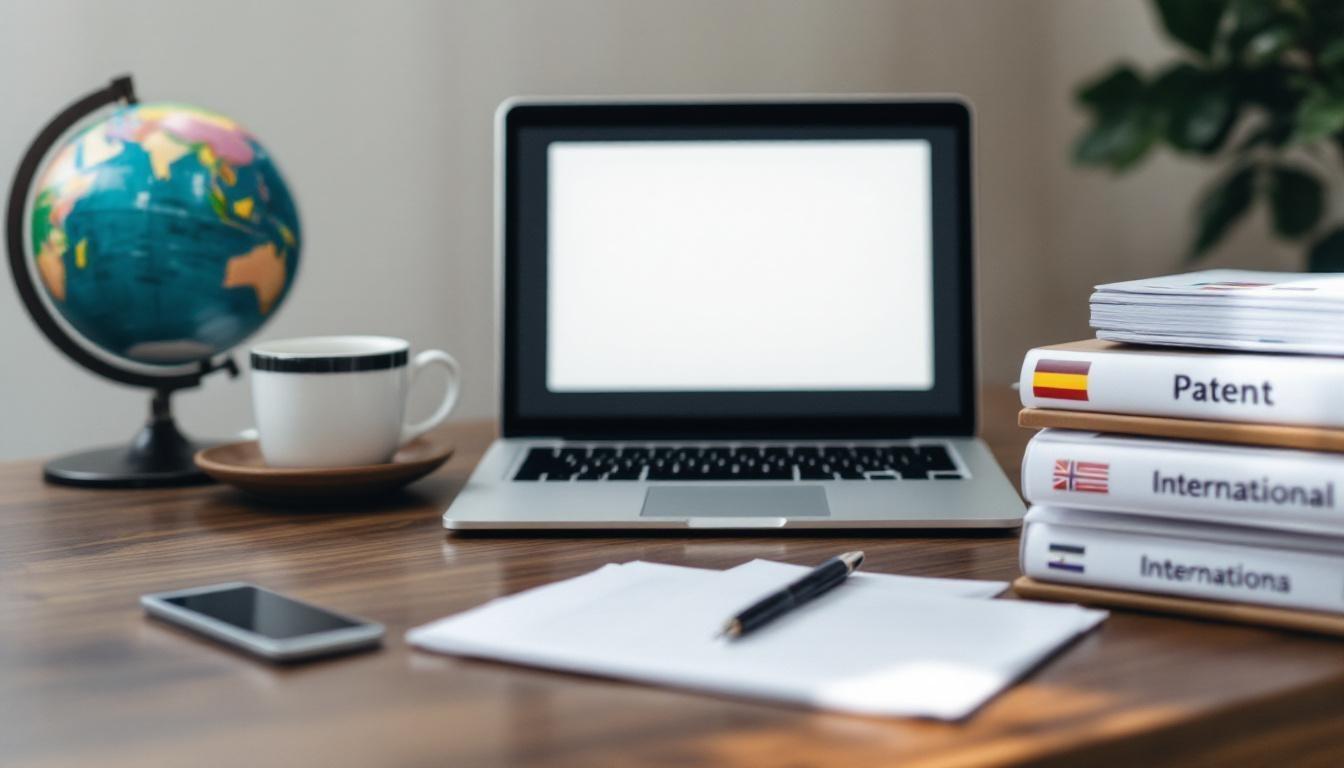International Patent Filing Process Demystified for Orlando, Florida
Orlando inventors and businesses face complex decisions when protecting intellectual property globally. The international patent filing process involves multiple pathways, each with distinct advantages and costs.
We at Daniel Law Offices, P.A. guide clients through PCT applications, direct national filings, and strategic timing considerations. Understanding these options helps inventors make informed decisions about global patent protection.
Which International Filing Route Saves Time and Money
The Patent Cooperation Treaty offers Orlando inventors a streamlined path to global patent protection across 153 countries with a single application. The PCT route provides an 18-month evaluation period before inventors commit to expensive national phase entries, which allows them to assess market potential and refine their inventions. WIPO statistics show that approximately 20% of PCT applications are withdrawn after the international search report, which saves inventors substantial costs on unviable patents. The PCT system delays translation costs and national fees for up to 30 months from the priority date (providing financial flexibility that direct national filing cannot match).
PCT Application Process Delivers Strategic Advantages
The PCT process begins when inventors file an international application through the USPTO as the receiving office, followed by an international search within 16 months. Orlando inventors benefit from the International Search Report and Written Opinion, which provides valuable insights into patentability before expensive national phase decisions.

The top five countries for national phase entries in 2022 were China, the United States, Japan, Europe, and South Korea according to WIPO reports. This data helps inventors prioritize markets based on commercial viability rather than speculation.
Direct National Filing Creates Higher Immediate Costs
Direct national filing requires simultaneous applications in each target country, which creates immediate translation expenses and local agent fees that can exceed $50,000 for multiple jurisdictions. Orlando inventors who choose this route face upfront costs without the benefit of international search insights. The Madrid Protocol provides similar consolidation benefits for trademark protection (allowing registration across multiple countries through a single application). However, patent protection requires either PCT filing or direct national applications, with PCT offering superior cost management and strategic flexibility for most Orlando inventors.
Cost Analysis Reveals Clear Financial Benefits
The financial advantages of PCT filing become apparent when inventors compare immediate expenses versus delayed costs. Direct national filing forces inventors to pay all fees upfront without knowledge of patent viability, while PCT filing allows strategic decisions based on search results. Translation costs alone can reach $2,000-$5,000 per country, making the PCT’s delayed payment structure valuable for budget management. These cost considerations directly impact how inventors should plan their international patent budgets and timeline expectations.
How Do You Navigate Complex International Patent Requirements
Successful international patent protection requires meticulous preparation across multiple jurisdictions, with prior art searches serving as the foundation for viable applications. Orlando inventors must conduct comprehensive searches beyond the USPTO database and utilize the European Patent Office database and WIPO Global Brand Database to identify existing patents that could impact their applications. The USPTO Patent Public Search tool provides access to over 11 million patent documents, while Google Patents offers additional search capabilities across 17 patent offices worldwide. Statistics from the USPTO show that over 80% of patent applications face issues with inadequate prior art searches, which directly leads to rejections and costly revisions. Smart inventors allocate 15-20% of their total patent budget to thorough search activities before they file any applications.
Documentation Standards Vary Significantly Between Countries
Patent offices across different countries impose distinct requirements that inventors must address carefully. The European Patent Office requires more detailed technical specifications than the USPTO standards, while China’s patent office mandates specific formats for technical drawings and claims structure that differ from U.S. requirements. Japan requires precise terminology translations that can affect patent scope (making professional translation services essential for success). The Patent Cooperation Treaty standardizes some requirements, but national phase entries still demand country-specific documentation adjustments. Orlando inventors who prepare comprehensive technical specifications upfront reduce translation costs by 30-40% compared to those who rely on basic documentation.
Priority Date Management Determines Global Patent Success
The priority date establishes patent rights across all jurisdictions and makes timing decisions fundamental to international protection strategies. Inventors have exactly 12 months from their first patent application to claim priority in additional countries through PCT or direct national applications. The 30-month PCT deadline for national phase entry provides strategic flexibility, but inventors who miss this deadline forfeit patent rights in target countries permanently. WIPO data indicates that 15% of PCT applications fail to enter national phases due to missed deadlines (representing lost opportunities worth millions in potential patent protection). Orlando inventors should establish clear timeline calendars with legal counsel to track critical deadlines and maintain global patent rights throughout the process.
Translation Requirements Create Hidden Expenses
Professional translation services become necessary when inventors enter national phases in non-English speaking countries. Technical patent translations cost between $2,000-$5,000 per country and require translators who understand both legal terminology and technical concepts. Patent offices in Germany, France, and Japan reject applications with inadequate translations at rates exceeding 25%, which forces inventors to pay additional fees for corrections and resubmissions. These translation expenses compound quickly when inventors target multiple markets simultaneously, making budget planning essential for international patent success.

What Do International Patents Actually Cost
Orlando inventors face staggering cost differences between domestic and international patent protection, with USPTO fees starting at $330 for small entities while comprehensive global protection can exceed $100,000. The USPTO charges $1,350 for large entities that file utility patents, but international applications through the Patent Cooperation Treaty require additional fees of $1,330 for international applications plus $2,080 for international search and preliminary examination. Direct national applications create immediate expenses that dwarf PCT costs, with European Patent Office applications that cost €1,330 plus €630 per country designation, while Japan charges ¥14,000 and China demands ¥950 for basic applications before translation expenses.
Translation Costs Multiply Rapidly Across Jurisdictions
Professional patent translation services charge $2,000 to $5,000 per country for technical documents, with complex software patents that reach $8,000 per jurisdiction due to specialized terminology requirements. German and Japanese translations cost 40% more than other languages because patent offices in these countries reject applications with technical inaccuracies at rates that exceed 30%. Local patent agents add another $3,000 to $7,000 per country for national phase entry assistance, prosecution support, and correspondence management with foreign patent offices. Orlando inventors who target five major markets face translation and agent costs between $25,000 and $60,000 before they consider maintenance fees.
Maintenance Fees Create Long-Term Financial Commitments
Patent maintenance requires payments that escalate throughout the 20-year protection period, with the USPTO that demands $800, $1,800, and $3,700 at years 3.5, 7.5, and 11.5 respectively for small entities. European patents cost €470 annually per designated country after grant, while Japanese maintenance fees start at ¥4,300 in year one and increase to ¥81,200 by year ten. Chinese patents require annual fees that begin at ¥900 and reach ¥8,000 by year twenty (which creates cumulative costs that exceed $50,000 for comprehensive global protection). Smart inventors budget 60% of total patent costs for post-grant maintenance and prosecution activities rather than focus solely on initial expenses.
Hidden Costs Accumulate Throughout the Process
Patent prosecution generates unexpected expenses that inventors often overlook when they plan their budgets. Office actions from foreign patent offices trigger response fees between $2,000 and $5,000 per country, with complex rejections that require multiple rounds of amendments and arguments. Appeal procedures in Europe cost €2,555 plus oral hearing fees of €4,205, while Japanese appeals demand ¥55,000 plus attorney fees that typically reach $10,000 per case. Patent offices also impose search fees, examination fees, and publication costs that vary significantly between jurisdictions and can add $15,000 to $30,000 to total protection expenses across major markets.
Final Thoughts
International patent protection transforms Orlando businesses from local players into global competitors with legally protected market positions. Companies that secure patents across major markets generate 23% higher revenues than those with only domestic protection, according to USPTO data. The international patent filing process demands strategic planning, substantial financial commitment, and professional guidance to navigate successfully.
Patent attorneys become essential when inventors face complex jurisdictional requirements and tight deadlines. We at Daniel Law Offices, P.A. guide Orlando inventors through comprehensive patent searches, application drafts, and USPTO procedures that form the foundation for successful international protection. Our registered patent attorney helps clients develop strategic approaches that maximize patent value while managing costs effectively (without compromising quality or protection scope).

Orlando inventors should begin their international patent journey with thorough market research and prior art searches before they commit to expensive global applications. The PCT route offers the most cost-effective path for most inventors and provides 30 months to evaluate market potential before expensive national phase decisions. Daniel Law Offices, P.A. assists inventors throughout this process, from initial patent searches through international application management and prosecution support.

